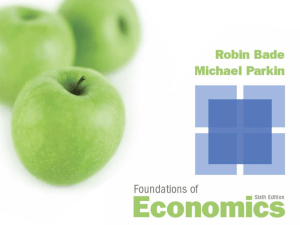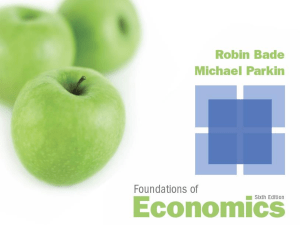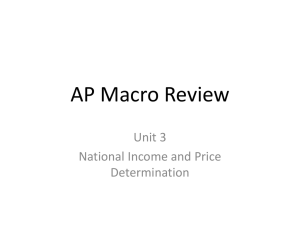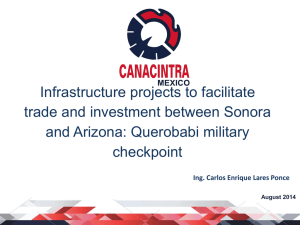Ch 29
advertisement
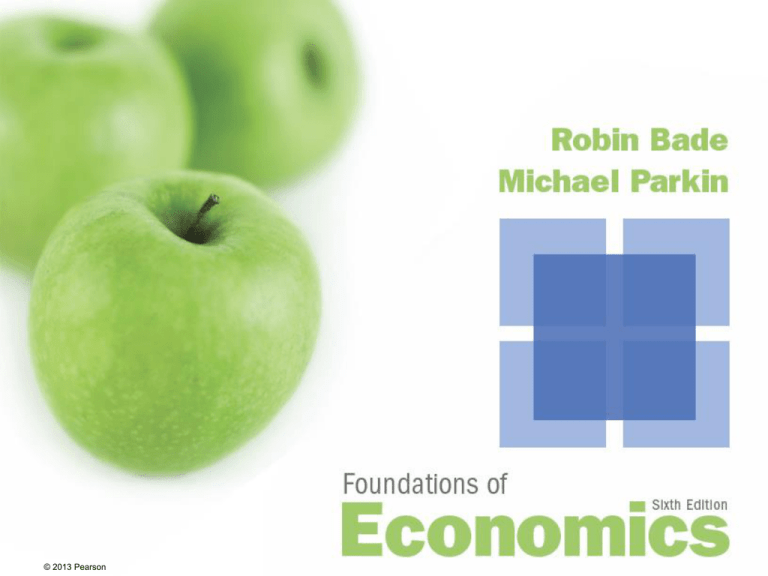
Click on the button to go to the problem © 2013 Pearson Aggregate Supply and Aggregate Demand 29 CHECKPOINTS © 2013 Pearson Click on the button to go to the problem Checkpoint 29.1 Problem 1 In the news Clicker version Checkpoint 29.2 Problem 1 Clicker version Checkpoint 29.3 Problem 1 Problem 2 Problem 2 Clicker version In the news Problem 3 Clicker version In the news © 2013 Pearson CHECKPOINT 29.1 Practice Problem 1 Explain the influence of each of events on the quantity of real GDP supplied and aggregate supply in India and use a graph to illustrate. • Fuel prices rise. • U.S. firms move their IT and data functions to India. • Wal-Mart and Starbucks open in India. • Universities in India increase the number of engineering graduates. • The money wage rate in India rises. • The price level in India rises. © 2013 Pearson CHECKPOINT 29.1 Solution As fuel prices rise, the quantity of real GDP supplied at the current price level decreases. The AS curve shifts leftward. © 2013 Pearson CHECKPOINT 29.1 As businesses move their IT and data functions to India, real GDP supplied at the current price level increases. The AS curve shifts rightward. © 2013 Pearson CHECKPOINT 29.1 As Wal-Mart and Starbucks open in India, the quantity of real GDP supplied at the current price level increases. The AS curve shifts rightward. © 2013 Pearson CHECKPOINT 29.1 With more engineering graduates, the number of skilled workers increases, and production increases at the current price level. The AS curve shifts rightward. © 2013 Pearson CHECKPOINT 29.1 As money wage rates rises, firms’ costs increase and the quantity of real GDP supplied at the current price level decreases. The AS curve shifts leftward. © 2013 Pearson CHECKPOINT 29.1 As the price level increases, other things remaining the same, businesses become more profitable. As the price level increases, firms increase the quantity of real GDP supplied along the AS curve. The AS curve does not shift. © 2013 Pearson CHECKPOINT 29.1 Study Plan Problem U.S. firms move their IT and data functions to India. In the short run, India’s aggregate supply _________. A. increases B. doesn’t change, but U.S. aggregate supply increases C. decreases because more of India’s workers are now employed by U.S. firms D. doesn’t change, but a higher price level brings an increase in the quantity of real GDP supplied © 2013 Pearson CHECKPOINT 29.1 Fuel prices rise in India. In the short run, India’s aggregate supply _________. A. increases B. doesn’t change, the quantity of real GDP supplied decreases C. doesn’t change, but the quantity of real GDP supplied increases D. decreases © 2013 Pearson CHECKPOINT 29.1 Wal-Mart and Starbucks open in India. In the short run, India’s aggregate supply _______. A. increases B. doesn’t change, the quantity of real GDP supplied decreases C. doesn’t change, but the quantity of real GDP supplied increases D. decreases © 2013 Pearson CHECKPOINT 29.1 Universities in India increase the number of engineering graduates. In the short run, India’s aggregate supply _______. A. doesn’t change, the quantity of real GDP supplied decreases B. increases C. doesn’t change, but the quantity of real GDP supplied increases D. decreases © 2013 Pearson CHECKPOINT 29.1 The money wage rate in India rises. In the short run, India’s aggregate supply _______. A. doesn’t change, but the price level rises and the quantity of real GDP supplied increases B. increases C. doesn’t change, but the price level falls and the quantity of real GDP supplied decreases D. decreases © 2013 Pearson CHECKPOINT 29.1 The price level in India rises. In the short run, India’s aggregate supply _______. A. doesn’t change, but the quantity of real GDP supplied decreases B. increases C. doesn’t change, but the quantity of real GDP supplied increases D. decreases © 2013 Pearson CHECKPOINT 29.1 In the news Minimum wage to rise in eight states Colorado, Montana, Ohio, Washington, and Oregon recently announced their 2012 minimum wages, which contain rises ranging from 28 cents to 37 cents per hour. Thus translates into annual raises of between$582 and $770 for full-time workers. Source: CNN Money, October 3, 2011 Explain how the rise in the minimum wage will influence aggregate supply. © 2013 Pearson CHECKPOINT 29.1 Solution The rise in the minimum wage at the current price level increases the real wage rate and decreases aggregate supply. If the rise in the minimum wage rate increases the natural unemployment rate, potential GDP decreases and aggregate supply decreases farther. © 2013 Pearson CHECKPOINT 29.2 Practice Problem 1 Mexico trades with the United States. Explain the effect of each of the following events on Mexico’s aggregate demand. • The government of Mexico cuts income taxes. • The United States experiences strong economic growth. • Mexico sets new environmental standards that require factories to upgrade their production facilities. © 2013 Pearson CHECKPOINT 29.2 Solution A tax cut increases disposable income, which increases Mexico’s aggregate demand. The AD curve shifts rightward. © 2013 Pearson CHECKPOINT 29.2 Strong U.S. growth increases the demand for Mexicanproduced goods and increases Mexico’s aggregate demand. The AD curve shifts rightward. © 2013 Pearson CHECKPOINT 29.2 As factories upgrade their facilities, investment increases. Aggregate demand increases. The AD curve shifts rightward. © 2013 Pearson CHECKPOINT 29.2 Study Plan Problem If the government of Mexico cuts income taxes,Mexico’s aggregate demand _________. A. decreases, and the AD curve shifts leftward B. increases, and the AD curve shifts rightward C. is unchanged because it just increases the amount that taxpayers transfer to the government D. is unchanged, but the price level rises and the quantity of real GDP demanded decreases © 2013 Pearson CHECKPOINT 29.2 Mexico trades with the United States. If the United States experiences strong economic growth, Mexico’s aggregate demand _________. A. decreases and the AD curve shifts leftward B. is unchanged, but the quantity of real GDP demanded increases C. is unchanged, but U.S. aggregate demand increases D. increases because its exports to the United States increases © 2013 Pearson CHECKPOINT 29.2 When Mexico sets new environmental standards that require factories to upgrade their production facilities. Mexico’s aggregate demand _________. A. increases because investment increases B. is unchanged, but the quantity of real GDP demanded increases C. is unchanged, but the quantity of real GDP demanded decreases D. decreases © 2013 Pearson CHECKPOINT 29.2 Practice Problem 2 Explain the effect of each of the following events on Mexico’s aggregate demand. • Europe trades with Mexico and Europe goes into recession. • The price level in Mexico rises. • Mexico increases the quantity of money. © 2013 Pearson CHECKPOINT 29.2 Solution A recession in Europe decreases European demand for Mexican goods. Mexico’s exports decrease. Aggregate demand decreases and the AD curve shifts leftward. © 2013 Pearson CHECKPOINT 29.2 A rise in the price level decreases the quantity of real GDP demanded along the AD curve, but the AD curve does not shift. © 2013 Pearson CHECKPOINT 29.2 An increase in the quantity of money increases aggregate demand, and the AD curve shifts rightward. © 2013 Pearson CHECKPOINT 29.2 In the news Durable goods orders fall, new-homes sales pick up The BEA announced that demand for durable goods fell 5.3%, while new-home sales rose 4.2% in the second quarter of 2011. U.S. exports increased 3.6%. Source: BEA, September 29, 2011 Explain how the items in the news clip influence U.S. aggregate demand. © 2013 Pearson CHECKPOINT 29.2 Solution The purchase of durable goods and new homes is investment. A decrease in durable goods sales decreases aggregate demand, while the increase in new home sales increased aggregate demand. The rise in U.S. exports is an increase in the demand for U.S.-produced goods and services, so the rise in U.S. exports increased U.S. aggregate demand. © 2013 Pearson CHECKPOINT 29.3 Practice Problem 1 The U.S. economy is at full employment when the following events occur: • A deep recession hits the world economy. • The world oil price rises by a large amount. • U.S. businesses expect future profits to fall. Explain the effect of each event separately on aggregate demand and aggregate supply. How will real GDP and price level change in the short run? © 2013 Pearson CHECKPOINT 29.3 Solution A deep recession in the world economy decreases U.S. aggregate demand. The AD curve shifts leftward. In the short run, U.S. real GDP decreases and the price level falls. © 2013 Pearson CHECKPOINT 29.3 A rise in the world oil price decreases U.S. aggregate supply. The AS curve shifts leftward. In the short run, U.S. real GDP decreases and the price level rises. © 2013 Pearson CHECKPOINT 29.3 A fall in expected future profits decreases U.S. aggregate demand. The AD curve shifts leftward. In the short run, U.S. real GDP decreases and the price level falls. © 2013 Pearson CHECKPOINT 29.3 Practice Problem 2 The U.S. economy is at full employment when the following events occur: • A deep recession hits the world economy. • The world oil price rises by a large amount. • U.S. businesses expect future profits to fall. Explain the combined effect of these events on real GDP and price level. © 2013 Pearson CHECKPOINT 29.3 Solution All three events decrease U.S. real GDP. The deep world recession and the fall in expected future profits decrease the price level. The rise in the world oil price increases the price level. So the combined effect on the price level is ambiguous. © 2013 Pearson CHECKPOINT 29.2 Study Plan Problem The U.S. economy is at full employment when a deep recession hits the world economy, the world oil price rises by a large amount, and U.S. businesses expect future profits to fall. A. The U.S. price level rises and real GDP decreases B. The U.S. price level falls and real GDP decreases C. U.S. real GDP decreases, but the price level might rise or fall. D. U.S. real GDP increases, but the price level might rise or fall. © 2013 Pearson CHECKPOINT 29.3 Practice Problem 3 The U.S. economy is at full employment when the following events occur: • A deep recession hits the world economy. • The world oil price rises by a large amount. • U.S. businesses expect future profits to fall. Which event, if any, brings stagflation? © 2013 Pearson CHECKPOINT 29.3 Solution Stagflation occurs when the price level rises and real GDP decreases at the same time. The rise in the world oil price brings stagflation because it decreases aggregate supply, decreases real GDP, and raises the price level. © 2013 Pearson CHECKPOINT 29.2 Study Plan Problem The U.S. economy is at full employment. Stagflation occurs, if ______. A. a deep recession hits the world economy B. the world oil price rises by a large amount C. U.S. businesses expect future profits to fall. D. A, or B, or C occur. © 2013 Pearson CHECKPOINT 29.3 In the news U.S. incomes fall for the first time in 2 years Consumer spending rose 0.2 percent, down from 0.7 percent in July. Incomes fell 0.1 percent—the first decline since October 2009. Consumer spending accounts for 70 percent of economic activity. Source: Associated Press, September 30, 2011 Explain the combined effect of these events in terms of the AS-AD model. © 2013 Pearson CHECKPOINT 29.3 Solution The news clip gives no information about aggregate supply. Consumption expenditure is 70 percent of aggregate demand, so an increase in consumption expenditure would increase aggregate demand, GDP, and aggregate incomes. © 2013 Pearson CHECKPOINT 29.3 But incomes fell, so the other components of aggregate demand (investment, government expenditure, net exports) must have decreased, …. moving the economy down along the AS curve. Or aggregate supply must have decreased, moving the economy up along the AD curve. © 2013 Pearson


